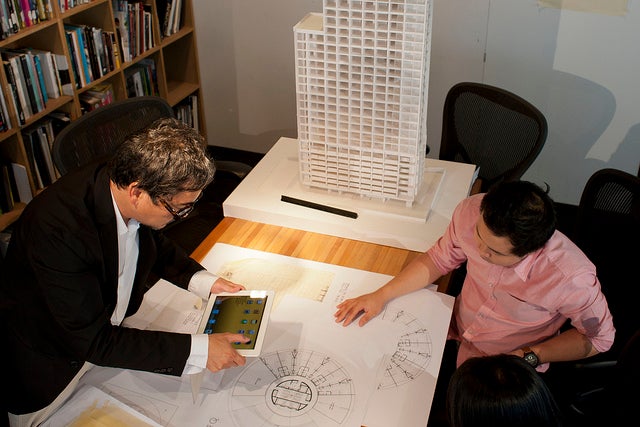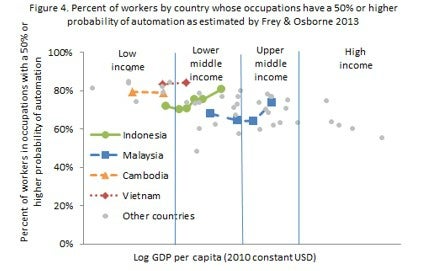
Recent trends in automation and rapid technology advances, collectively dubbed ‘The Fourth Industrial Revolution (“4IR”), are radically shifting the economic landscape, and changing the nature of jobs and the profile of skills required in the labor force. There are challenges emerging around the world and East Asia is getting ready.
A global challenge
As automation expands, low-skilled and low-income countries become more exposed to automation. Because of job clustering, reskilling and acquiring skills such as complex problem-solving, high-level technical skills, and social skills have become more important for workers to adapt to new and emerging industries. The challenges facing the global force will be significant and require collaborative and innovative emphasis on enhanced methods for developing the skills needed to adapt and remain productive. Carl Benedikt Frey of the Oxford Martin Programme on Technology and Employment, reminds us that, “The emergence of new industry suggests that the new types of jobs being developed are vastly more skilled than the average types of jobs.”
The need to focus more heavily on advanced skills has significant implications for education and training systems around the world that need to ensure they are producing graduates prepared for fast-changing economies. Government cooperation with the private sector is important for aligning skills development with changing economic and labor market demands. According to Sunny Park of Microsoft Korea, “In order to tackle this shift, we need to create the right culture and innovative workplace to ensure that people are being creative and are able to develop the skillsets they need to succeed in 4IR.” Microsoft itself is taking this approach through a recent move to a growth mindset, which implies that talent is not fixed but can be developed overtime by everyone.
There’s no way around it, technology matters
A fundamental approach recommended by Tom Vander Ark of Getting Smart is that countries will need to support the development of innovative learning ecosystems. His framework combines deep learning, big data and enabling technology, and transforms every sector of human endeavor. To prepare for the challenges ahead, new learning frameworks will need to be introduced. An innovative example is MyWays Competencies, a framework that synthesizes 20 competencies for success in learning, work, and life, and flipping the curriculum, which shifts curricular focus to emphasizing transfer and expertise over data and information.
East Asian Countries are retooling educations systems, and more…
How East Asia can best prepare for 4IR was the topic of discussion at this year’s annual ASEAN+3 Forum on Skills and Jobs, Enhancing Job Creation and Skills to Prepare for the Fourth Industrial Revolution.
While the East Asian growth model of the past has been very effective, it has also left many of the region’s countries reliant on occupations that are among those most likely to be automated.

Luckily, the region best known for capitalizing on global economic opportunities is again ahead of the curve and carrying out many innovative efforts to address 4IR at all levels of its training systems and throughout the entire lifecycle of its citizens. Here are a few examples:
- Korea has shifted to a competency-based society with lifelong access to job training through recent policies such as the National Competency Standards (NCS) and the Work-Learning Dual System.
- At the basic education level, the Philippines recently introduced a K-12 reform, which emphasizes cultural-responsiveness, flexibility, ICT-based learning and globalization in its curriculum. The reform also centers on strong community-industry partnerships and relevancy.
- Singapore has co-created a “Skills Framework” for its workforce by involving industry leaders, unions and government. The Framework provides information on a sector - including its future development - and maps out career progression pathways and resulting skills needs. These inform education and training institutions as well as individuals.
- Malaysia has launched the “Redesigning Higher Education” strategy, to prepare students for the 4IR. Programs range from 2u2i - which is a mix of university and in-house industry training- to CEO Faculty, where industry CEOs provide lectures, curriculum development and mentoring at universities. In addition, its Accreditation of Prior Experiential Learning (APEL) encourages lifelong learning and credits work experience towards further educational study..
- In Yunnan Province, China is remodeling its Agricultural Technical and Vocational Education (TVET) sector to include training models that rotate students between different areas of farming based on the characteristics of regional agricultural economies, work integrated learning (in which students share time between classroom and hands on farming), and a teacher-designed curriculum focused on student-driven learning.
Within the 4IR context, East Asian labor markets – like those elsewhere in our increasingly connected, tech-centered world – are beginning to demand more non-routine cognitive tasks and the interpersonal skills to carry them out. Already, socioemotional skills (SES) are associated with large income increases for women, less-educated workers, and those employed in the service sector.
To build SES skills, researchers have found that a solid foundation in basic and cognitive skills is necessary. The sooner we start, the better we learn and acquire skills throughout life.
We offer a framework of three policy priorities to prepare for the future, which includes an early focus on children’s development, implementing financial innovations, and enabling workers to invest in relevant skills for the labor market.
Are we ready for the Revolution? The agenda ahead is large and, as East Asia shows, one of the best ways to tackle it is to continue collaborating across countries and sectors, allowing regular exchange of ideas to give rise to innovative solutions. We must learn from each other so that we can continue to grow into the future.
Find out more about World Bank Education on our website and on Twitter.
Find out more about the World Bank Partnership for Skills Development in East Asia and the Pacific and the ASEAN + 3 Forum on skills here.
All our resources on skills and jobs are available here.
Get information about skills in East Asia and the Pacific here .


Join the Conversation